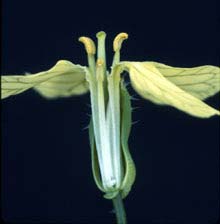Multitasking genes manage related traits in plants

Think of it as finding the ultimate genetic engineers.
A plant biologist at Michigan State University has harvested clues about genes that coordinate the development of plant parts that must work together.
The work, published in the Nov. 28 issue of the British science journal Nature, points to a single mechanism that regulates the growth of related parts in flowers – kind of a genetic project manager.
“This is why we’re not just a discombobulated collection of parts. We’re coordinated,” said paper author Jeffrey Conner, an associate professor of plant biology. “I found that the same genes can affect pairs of related traits.”
Scientists have understood that creatures evolve to optimize their ability to survive and reproduce, ultimately building a plant or animal better adapted to its environment.
In plants, this can be seen in the size and proportions of a flower. Flowers are serious business in the plant world, the ground zero of reproduction. The parts of a flower – the petal, stamen and pistil – must be precisely constructed to lure a pollinator in to both fertilize the plant and carry away genetic material in the pollen to other flowers.
If a flower’s tube – where the nectar is – was short in relation to its stamens, the male parts of the flower, a bee could dive in, nab nectar and leave without rubbing up against the anthers and picking up their pollen.
“A flower has to evolve to successfully manipulate the behavior of the animal that pollinates it to get what it needs,” Conner said. “The key is to make contact with the anthers and stigma. If that doesn’t happen, it’s worthless, from the plant’s point of view.”
Conner, who does his National Science Foundation–funded research at MSU’s Kellogg Biological Station, spent years randomly crossbreeding generations of wild radish to understand how the plant coordinates its floral parts to best reproduce.
He found that consistently the plant would evolve to make sure the flower’s tube and stamen parts developed in tight correlation, and that this development was traced to a number of genes doing double duty.
This genetic mechanism creates a design stability that carries the organism successfully through evolution.
While Conner works on plants, he said this tight orchestration is seen in all organisms. Genetic coordination, for instance, is the reason human arms don’t grow out of concert with legs and send people’s knuckles dragging to the ground.
“It keeps the parts in the right proportion, so they can do a job,” he said.
Understanding that a single gene affects more than one part can help reveal why plants are successful and how they maintain a structural stability over time.
It also, Conner said, opens new areas of study in all organisms about the role one gene, or group of genes, can play.
ADDITIONAL MEDIA CONTACT:
Sue Nichols, University Relations 517-355-2281
MEDIA COMMUNICATIONS
Division of University Relations
403 Olds Hall
Michigan State University
East Lansing, MI 48824-1047
Media Contact
More Information:
http://newsroom.msu.eduAll latest news from the category: Life Sciences and Chemistry
Articles and reports from the Life Sciences and chemistry area deal with applied and basic research into modern biology, chemistry and human medicine.
Valuable information can be found on a range of life sciences fields including bacteriology, biochemistry, bionics, bioinformatics, biophysics, biotechnology, genetics, geobotany, human biology, marine biology, microbiology, molecular biology, cellular biology, zoology, bioinorganic chemistry, microchemistry and environmental chemistry.
Newest articles

First-of-its-kind study uses remote sensing to monitor plastic debris in rivers and lakes
Remote sensing creates a cost-effective solution to monitoring plastic pollution. A first-of-its-kind study from researchers at the University of Minnesota Twin Cities shows how remote sensing can help monitor and…

Laser-based artificial neuron mimics nerve cell functions at lightning speed
With a processing speed a billion times faster than nature, chip-based laser neuron could help advance AI tasks such as pattern recognition and sequence prediction. Researchers have developed a laser-based…

Optimising the processing of plastic waste
Just one look in the yellow bin reveals a colourful jumble of different types of plastic. However, the purer and more uniform plastic waste is, the easier it is to…



